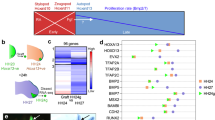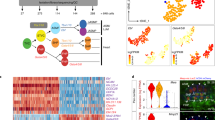Abstract
In classical embryology, the term ‘determination’ was used to describe the process by which a region of the embryo became committed to form a particular part of the body and it was understood that there was a particular stage of development at which determination occurred with respect to each decision1–3. Some authors4,5 insisted that only an irreversible commitment should be described as determination, but this leaves undefined the nature of the preceding events involved in its establishment. We show here that there may be several stages of commitment for an organ rudiment that can be distinguished from one another by the use of different methods for altering the pathway of development. We have investigated the region of the amphibian mesoderm that is destined to become somitic muscle in the course of normal development and applied to it a variety of isolation and grafting techniques. The results, which show an extensive period of lability within this region, can be used to explain how pattern formation might occur within the dorsoventral axis of the mesoderm.
This is a preview of subscription content, access via your institution
Access options
Subscribe to this journal
Receive 51 print issues and online access
$199.00 per year
only $3.90 per issue
Buy this article
- Purchase on Springer Link
- Instant access to full article PDF
Prices may be subject to local taxes which are calculated during checkout
Similar content being viewed by others
References
Spemann, H. Embryonic Development and Induction (Hafner, New York, 1967).
Weiss, P. Principles of Development (Hafner, New York, 1969).
CIBA Symp. 40, 103–110 (1976).
Waddington, C. H. Principles of Embryology (Allen and Unwin, London, 1956).
Needham, J. Biochemistry and Morphogenesis (Cambridge University Press, 1942).
Holtfreter, J. Wilhelm Roux Arch. Entw Mech. Org. 138, 522–656; 675–738 (1938).
Holtfreter, J. & Hamburger, V. in Analysis of Development (eds Willier, B. H., Weiss, P.A. & Hamburger, V.) 230–296 (Saunders, Baltimore 1955).
Yamada, T. Wilhelm Roux Arch. Entw Mech. Org. 137, 151–270 (1937).
Fankhauser, G. & Humphrey, R. R. Proc. natn. Acad. Sci. U.S.A. 29, 344–350 (1943).
Yamada, T. Biol. Bull. mar. biol. Lab., Woods Hole 98, 98–121 (1950).
Slack, J. M. W. & Forman, D. J. Embryol. exp. Morph. 56, 283–299 (1980).
Hörstadius, J. Experimental Embryology of Echinoderms (Clarendon, Oxford, 1973).
Sander, K. Adv. Insect Physiol. 12, 125–238 (1976).
Bordzilovskaya, N. P. & Detlaff, T. A. Axolotl Newslett. 7 (1979).
Author information
Authors and Affiliations
Rights and permissions
About this article
Cite this article
Forman, D., Slack, J. Determination and cellular commitment in the embryonic amphibian mesoderm. Nature 286, 492–494 (1980). https://doi.org/10.1038/286492a0
Received:
Accepted:
Issue Date:
DOI: https://doi.org/10.1038/286492a0
This article is cited by
-
Two essential processes in the formation of a dorsal axis during gastrulation of Cynops embryo
Roux's archives of developmental biology (1994)
-
A cascading development model for amphibian embryos
Bulletin of Mathematical Biology (1989)
-
Neural-inducing activity of newly mesodermalized ectoderm
Roux’s Archives of Developmental Biology (1986)
-
Scale of body pattern adjusts to available cell number in amphibian embryos
Nature (1981)
Comments
By submitting a comment you agree to abide by our Terms and Community Guidelines. If you find something abusive or that does not comply with our terms or guidelines please flag it as inappropriate.



